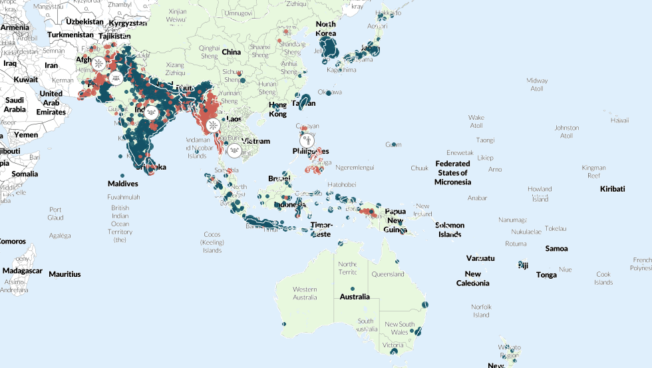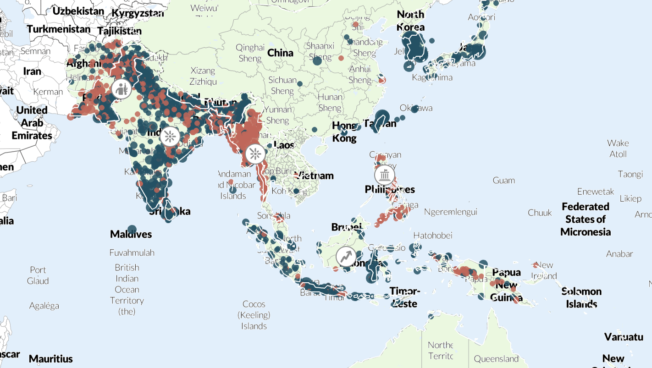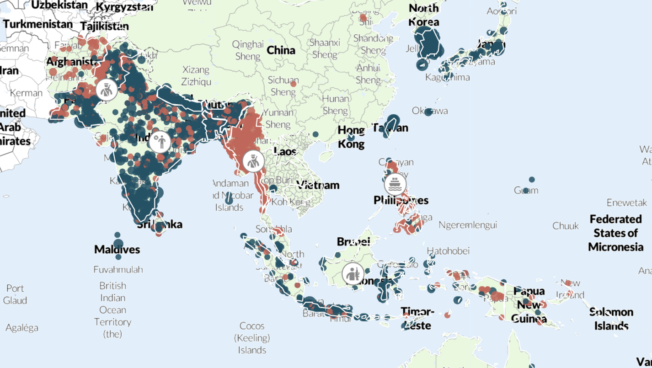Regional Overview
Asia-Pacific
July 2024
Posted: 8 August 2024
In this Regional Overview
- Bangladesh: PM Hasina steps down after weeks of deadly anti-government demonstrations
- India: Intensified fighting between security forces and militants in Jammu and Kashmir
- Indonesia: Deadly military operation exacerbates tensions between ethnic Papuans and non-Papuan migrants in Central Papua
- Korean Peninsula: Tensions continued at the border and east coast
- Myanmar: Resistance forces capture major towns in northern Mandalay and Shan state
- Papua New Guinea: Violence in East Sepik kills at least 26
Bangladesh: PM Hasina steps down after weeks of deadly anti-government demonstrations
Bangladesh Prime Minister Sheikh Hasina resigned and fled to India by helicopter on 5 August following weeks of deadly anti-government demonstrations. This ended her 15 years of rule over the country and prompted the call for new elections. In January, Hasina won a fifth term as prime minister in an election boycotted by the opposition and characterized by low turnout and government repression.
Thousands of Bangladeshi students took to the streets in July against a High Court verdict to reintroduce affirmative action measures, locally known as quotas, in government jobs.1Al Jazeera, ‘What’s behind Bangladesh’s violent quota protests?,’ 16 July 2024 The quota system reserved 30% of government jobs for relatives of veterans who had fought in Bangladesh’s 1971 war of independence against Pakistan, among other groups. This was seen as a form of patronage for those affiliated with the ruling Awami League (AL) party, the pioneer of the independence movement.2The Economist, ‘Protests in Bangladesh put an end to a corrupt quota system,’ 21 April 2018
The protest movement, which began mainly as peaceful protests led by students in university towns, turned violent in mid-July after Prime Minister Hasina referred to the demonstrators as Razakar sympathizers, a highly charged term that refers to collaborators during the 1971 war of independence.3Kelly Ng, Subhajyoti Ghosh, and BBC Bangla, ‘Bangladesh PM blames political foes for violence,’ BBC News, 23 July 2024 Students were joined by opposition supporters, mainly from the Bangladesh Nationalist Party (BNP) and the Jamaat-e-Islami (JeI). Police launched a heavy crackdown on the demonstrators, leading to heavy clashes that also involved armed members of the Bangladesh Chhatra League, the AL’s student wing. Around half of all demonstrations involved violence between the various protest groups and security forces. While demonstrators vandalized public property and threw stones and brickbats, police responded with live ammunition, rubber bullets, and tear gas shelling. Some reports estimate that at least 400 demonstrators may have died since the protest movement broke out.4Samira Hussein and Simon Fraser, ‘Inside Bangladesh: BBC finds country in shock but dreaming of change,’ BBC News, 7 August 2024
During the clashes, the government imposed a nationwide curfew and communications blackout, deployed the army, and arrested thousands.5Lipika Pelham, ‘Fresh violence in Bangladesh student protests,’ BBC News, 31 July 2024 Even as the Supreme Court struck down the majority of quotas in a verdict issued on 21 July,6Kelly Ng, Subhajyoti Ghosh, and BBC Bangla, ‘Bangladesh PM blames political foes for violence,’ BBC News 23 July 2024 demonstrations once again erupted in the last week of July, as student demands shifted toward broader issues of justice and accountability for violence against demonstrators. While the government accused opposition parties, mainly the BNP and JeI, of co-opting the student-led movement and turning them violent, the demonstrators blamed police and the then-ruling party for the violence.7Redwan Ahmed and Hannah Ellis-Petersen, ‘Bangladeshi students allege police torture after protests crackdown,’ The Guardian, 23 July 2024 The Office of the United Nations High Commissioner for Human Rights has called for an independent investigation into all allegations of human rights violations committed during the demonstrations.8Office of the High Commissioner for Human Rights, ‘Bangladesh: Türk decries government crackdown, urges respect for international human rights standards,’ United Nations, 25 July 2024
For more, see ACLED’s report on The Violent Politics of Bangladesh’s 2024 Elections.
India: Intensified fighting between security forces and militants in Jammu and Kashmir
Clashes between Indian security forces and militants nearly doubled in the restive Jammu and Kashmir region in July compared to June. With around 29 fatalities reported across 20 events, ACLED data show that armed clashes in July resulted in the highest number of fatalities in nearly two years. On 8 July, militants from the Kashmir Tigers group reportedly killed five soldiers during an ambush on an army convoy in Kathua district, marking the deadliest attack on security forces this year. The increase in activity comes in contrast to newly re-elected Prime Minister Narendra Modi’s statement to parliament earlier in the month that the “fight against terrorism” in Jammu and Kashmir was in its final stage.9Al Jazeera, ‘‘New wave’: Why suspected rebel attacks are rising in Kashmir’s Jammu area,’ 1 August 2024
Among the militant groups active in Kashmir, the Kashmir Tigers and the Resistance Front were involved in nearly a quarter of all encounters with security forces. The two groups emerged after the abrogation of Jammu and Kashmir’s special status in 2019 and are believed to be fronts for the Pakistan-based Jaish-e-Mohammad and Lashkar-e-Taiba, respectively.10Sudha Ramachandran, ‘Anti-India Militancy Returns to Srinagar,’ The Diplomat, 17 December 2021 In July, security forces also foiled at least three cross-border infiltration attempts along the Line of Control, resulting in the reported fatalities of at least five suspected militants of Pakistani origin. Most of the violence was concentrated in and around Jammu division, an area that has been relatively peaceful compared to the rest of the region. Experts attribute the geographical shift to the security forces’ successes in countering militancy in the Kashmir valley and the availability of ample hideouts in Jammu’s dense forests.11Al Jazeera, ‘‘New wave’: Why suspected rebel attacks are rising in Kashmir’s Jammu area,’ 1 August 2024 In response to the escalating clashes, the government increased its deployment of security personnel in the Jammu region.12Dinakar Peri, ‘Around 3,000 Army troops, 500 special forces inducted into Jammu area,’ The Hindu, 19 July 2024; Sunil Bhat, ‘Over 40 Pak terrorists hiding in hilly regions of Jammu, Army on alert: Sources,’ India Today, 22 July 2024
For more on the unrest around the 2024 Indian elections, see ACLED’s Special Election Series on India.
Indonesia: Deadly military operation exacerbates tensions between ethnic Papuans and non-Papuan migrants in Central Papua
In Central Papua, a deadly military operation triggered an outbreak of inter-ethnic violence, underlining ongoing tensions between ethnic Papuans and non-Papuans in the region. On 16 July, the Indonesian military and police forces shot dead three Papuans, including village heads in Pepera village of Mulia district, claiming they were rebels from the West Papua National Liberation Army (TPNPB).13evianto Pakiding, ‘Mob Burns Military and Police Vehicles in Papua after Deaths of Three Suspected Rebels,’ Jakarta Globe, 17 July 2024 In retaliation, hundreds of Papuan locals burned six security forces’ vehicles and killed a non-Papuan civilian, forcing hundreds of non-Papuan residents to flee.14Nasrun Katingka, ‘Alleged wrong shooting in Puncak Jaya, residents ask TNI for clarification,’ Kompas, 19 July 2024 Non-Papuan migrant workers are often perceived as beneficiaries and extensions of the Indonesian government. Both Papuan locals and TPNPB members often attack non-Papuan migrant workers and frequently accuse them of being spies or undercover security officers.15Tribunnews, ‘TPNPB-OPM accused the Indonesian military and police forces using civilians and local migrants as spies in Papua,’ 18 April 2021 Central Papua is one of the epicenters of the ongoing TPNPB separatist insurgency in Papua. In 2024, Central Papua accounted for the highest fatality numbers across Indonesia, reaching nearly 50 reported deaths in the first six months of the year. The number is more than double that of the second most turbulent province, Highland Papua.
Korean Peninsula: Tensions continued at the border and east coast
Tension between the two Koreas has reached its highest peak in years, with both countries violating military agreements and increased militarization at the border and the east coast. North Korea launched two ballistic missiles off its east coast on 1 July in response to trilateral military exercises between the United States, South Korea, and Japan in the East China Sea. It denounced the exercise, called the Freedom Edge drill, that involved simultaneous air and naval drills, calling it a step toward an Asian version of NATO and promising “offensive and overwhelming” countermeasures.16Hyung-jin Kim, ‘North Korea test-launches 2 ballistic missiles, after end of new US-South Korea-Japan drill,’ Associated Press, 1 July 2024 Pyongyang then claimed it successfully tested a “super-large warhead” missile, which South Korea disputed.17Hyung-jin Kim, ‘North Korea brags of new missile with ‘super-large warhead.’ Outsiders doubt the North’s claim,’ Associated Press, 2 July 2024
Amid the missile tests, North Korea secured a mutual defense agreement with Russia on 19 July, stipulating both parties would aid the other if attacked. Meanwhile, South Korea held frontline live-fire drills near disputed land and western sea borders with North Korea — the first exercise of its kind since the 2018 comprehensive military agreement between the two countries was suspended.18Hyung-jin Kim, ‘Sister of North Korean leader Kim calls South Korea’s live-fire drills ‘suicidal hysteria’,’ Associated Press, 8 July 2024 ACLED records 71 distinct missile tests into the Sea of Japan since 2022.
Myanmar: Resistance forces capture major towns in northern Mandalay and Shan state
In July, resistance forces led by the Myanmar National Truth and Justice Party/Myanmar National Democratic Alliance Army (MNTJP/MNDAA) and the Palaung State Liberation Front/Ta’ang National Liberation Army (PSLF/TNLA) captured three major towns in Mandalay region and Shan state. In parallel with last month’s launch of ‘Operation 1027 Part II,’ the Brotherhood Alliance-affiliated PSLF/TNLA and People’s Defense Forces (PDF) — operating under the command of the National Unity Government — launched Operation Shan-Man in June to expand the resistance forces’ control in Mandalay region and Shan state.19Burma News International & Myanmar Peace Monitor, ‘How far will the “Operation Shan-Man” Advance?,’ 8 July 2024 After weeks of intense fighting in northern Mandalay, the Mandalay People’s Defense Forces (PDF) captured Singu town on 16 July, and the PSLF/TNLA combined forces captured Mogoke town — a ruby mining hub — on 24 July.20The Irrawaddy, ‘TNLA, PDF Seize Myanmar’s Ruby Hub Mogoke From Junta,’ 25 July 2024
As part of Operation 1027 Part II, the MNDAA and allies were also able to capture the North Eastern Command, the largest military command in northern Shan state, and claim full control of nearby Lashio town by the end of July. The fall of the command is a significant blow for the military; it is the first time the military has lost a regional command in decades. Following its loss, outraged pro-military supporters called for the removal of commander-in-chief Min Aung Hlaing on social media.21Khit Thit media, ‘Ma Ba Tha and extreme nationalists heavily criticized Min Aung Hlaing leadership for the fall of North Eastern Military Regional Command,’ 3 August 2024
Overall, the operations contributed to a 61% increase in political violence in the Mandalay region and 103% in Shan state in July compared to June. Reported fatalities in Mandalay and northern Shan state in July were also at their highest levels for 2024. At least a dozen PDFs under the NUG and local allies are active in Operation Shan-Man and Operations 1027 Part II. The large number of individual armed groups involved in violence contributes to Myanmar continuing to rank as the country with the most armed group fragmentation, according to the mid-year update of the Conflict Index.
Papua New Guinea: Violence in East Sepik kills at least 26
At least 26 people, including many women and children, were killed in an attack perpetrated by members of the I Don’t Care (IDC) gang between 16 and 18 July in East Sepik province. Reports of the killings emerged a week after the fact when police finally reached the remote area in the north of the country. More than 30 members of the IDC gang attacked locals in Agrumara, Tamara, and Tambari villages in Angoram district following a land dispute.22Miriam Zarriga, ‘Five arrested in Angoram massacre,’ Post-Courier, 29 July 2024 Accusations of sorcery and retaliation for the killing of a gang leader are reported among the factors contributing to the violence.23Rod McGuirk, ‘Gang kills at least 26 villagers in remote Papua New Guinea, officials say,’ Associated Press, 26 July 2024; The National, ‘Gang accused of killings,’ 6 August 2024 Some villagers were beheaded, while others were shot. The group raped women and girls and burned houses, leading to the displacement of over 200 villagers.24Rod McGuirk, ‘Gang kills at least 26 villagers in remote Papua New Guinea, officials say,’ Associated Press, 26 July 2024; Majeleen Yanei, ‘UN shocked over Sepik atrocities,’ The National, 25 July 2024 Authorities said that the group had been linked to a series of crimes over the past five years in the area, and its members are under investigation for holding girls captive in forced marriages.25The National, ‘Gang accused of killings,’ 6 August 2024; Miriam Zarriga, ‘Five arrested in Angoram massacre,’ Post-Courier, 29 July 2024 Police have arrested 10 members of the gang with suspected involvement in the killings.26Miriam Zarriga, ‘No place to hide, suspects in Angoram mass murders arrested,’ Post-Courier, 5 August 2024 Between January and July, ACLED records at least 11 violent events in East Sepik, compared to seven during the same period in 2023 and four in 2022.
See More
See the Codebook and the User Guide for an overview of ACLED’s core methodology. For additional documentation, check the Knowledge Base. Region-specific methodology briefs can be accessed below.
Links:
- Methodology and Coding Decisions for Political Violence and Demonstrations in Afghanistan
- Methodology and Coding Decisions for Political Violence and Demonstrations in China and Taiwan
- Methodology and Coding Decisions for Political Violence and Demonstrations in Myanmar
- Methodology and Coding Decisions for Political Violence and Demonstrations in North Korea







